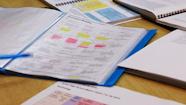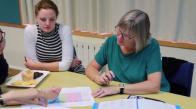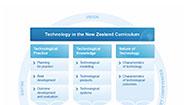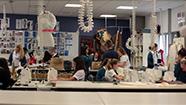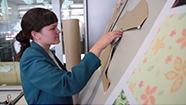Carol Rimmer explains how indicators of progression are woven into programmes of learning.
Using the indicators of progression in a secondary school
Transcript
Carol Rimmer: We like to meet as a department to develop generic units of work and assessment, particularly in the junior school. Before we start, we always like to look at anecdotal information and qualitative data and quantitative data that we have on our classes in order to make sure that what we are delivering is suitable for the students in front of us.
Once we have that data together, the big starting point is the broad context. To have contexts that will engage the students, we’ll flowchart what we think the teaching and learning will look like and then we get down to the nitty gritty, which is about the curriculum. The more experience we get at teaching technology, the more danger we are in of not actually meeting curriculum requirements. So at the stage of actually having a flowchart, we start to look at the step ups between the levels of four, five, six, seven, and eight, the new ideas to be taught at each level, and the literacy involved because that’s so important about preparing our students for the senior school.
The next step then is to use the indicators of progression. I particularly like to use the A3 sheets by level. We have them laminated so that we can work on them with highlighters. We use those to determine the level and the quality of what we are going to teach. They have teacher guidelines that give us clear ideas of the technological experiences that we should be delivering as teachers and the indications – whether we’re going to "provide", whether we’re going to "guide", or whether we’re going to "support" our students in their learning.
The indicators themselves show what we can expect from our students. They are very, very, clearly set out and in simple language and so it is important that we audit against our programmes to make sure that our students are getting the best opportunity that they can in our subjects and in our department.
At junior level, we use the indicators in the planning, but also in the assessment. Our assessment schedules use the indicators as to what we expect from the student and then in a simple terms we have an evidence column – what we actually want the students to hand in as part of the assessment task. So there’s no guesswork in what a student has to do to be working at the level that we are asking of them.
In the senior school, obviously we use achievement standards and it doesn’t take much to look at them to know that they are based on the indicators of progression. So the key is to use the indicators in the planning and then find the suitable achievement standard to assess the student, but only part of it. I hear in some schools, teachers or students saying they're studying an achievement standard. It should be a programme of learning that they have and then the teacher selects the most suitable assessment tool for that programme of learning.
So our challenge as teachers is to access this valuable information that we have on Technology Online. It is very easy to use, it is being updated all the time. It is our job as teachers to use it.
Related videos
School-wide programme planning (04:18)
Cheryl Pym explains how collaboration forms the foundation for school-wide planning in technology education.
Reviewing programme planning in years 7–13 (03:23)
At Diocesan School planning focuses on technology components for years 7–10, and establishing scholarship potential in year 13....
Review of curriculum implementation (03:49)
Margaret van Meeuwen explains how a cycle of self-review has enhanced delivery of curriculum.
A technology department with a digital and design focus (04:13)
Julie Clement shares how a design focus has engaged her students.
Resourcing for a digital and design focus (03:18)
Julie Clement considers how resources influence the authentic experiences for her students.

